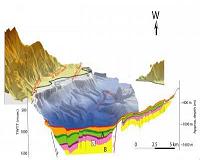| . |  |
. |
Paris (AFP) Jan 13, 2010 The quake that hit Haiti on Tuesday was a killer that had massed its forces for a century and a half before unleashing them against a wretchedly poor country, turning buildings into death traps, experts said on Wednesday. Scientists painted a tableau of horror, where natural forces, ignorance and grinding poverty had conspired to wreak a death toll tentatively estimated by Haitian Prime Minister Jean-Max Bellerive at more than 100,000. The 7.0-magnitude quake occurred very close to the surface near the Haitian capital of Port-au-Prince, leaving almost no natural buffer to soften the powerful shockwave, these experts said. "It was a very shallow earthquake, occurring at a depth of around 10 kilometers (6.2 miles)," seismologist Yann Klinger of the Institute of the Physics of the Globe (IPG) in Paris told AFP. "Because the shock was so big and occurred at such a shallow depth, just below the city, the damage is bound to be very extensive," he said. The US Geological Survey (USGS) said the quake occurred at 2153 GMT on Tuesday 15 kms (9.4 miles) southwest of Port-au-Prince. It happened at a boundary where two mighty chunks of the Earth's crust, the Caribbean plate and the North America plate, rub and jostle in a sideways, east-west movement. The USGS said the rupture occurred on the "Enriquillo-Plaintain Garden fault system," a slow-moving fault that last unleashed a large quake in 1860. Prior major events to that were in 1770, 1761, 1751, 1684, 1673 and 1618. Sandy Steacey, director of the Environmental Science Research Institute at the University of Ulster in Northern Ireland, said the high death toll could be pinned overwhelmingly to construction. "It's a very, very poor country without the building codes. Probably the fact that earthquakes (there) are very infrequent contributes in a way, because it's not a country that is focussed on seismic safety. "Looking at the pictures, essentially it looks as if (the buildings are of) breeze-block or cinder-block construction, and what you need in an earthquake zone is metal bars that connect the blocks so that they stay together when they get shaken," said Steacey. "In a wealthy country with good seismic building codes that are enforced, you would have some damage, but not very much." French seismologist Pascal Bernard, also at the IPG, said that, given the nature of the fault, there was a "sizeable probability" that another large quake could occur in the same region within a matter of years. Like other faults around the world, the Haitian crack is well known for domino activity, in which the release of pressure on one stretch piles on pressure in an adjoining stretch, bringing it closer to rupture. In Haiti's case, the likeliest spot of a bust would be to the east of Tuesday's quake, Bernard said. Asked whether another big quake was in the offing, Roger Searle, a professor of geophysics at Durham University, northeast England, said, "In the coming years, almost surely." "We know pretty much where earthquakes occur, they've been mapped themselves and we can map faults and so on. "The difficulty is it's very, very hard to predict when they will occur, because the network is so complex. "It's a bit like making a pile of stones. You put more on the pile and it gets steeper and steeper and sooner or later the thing is going to collapse but you never which stone is going to do it and just where it's going to start to fail."
Share This Article With Planet Earth
Related Links Tectonic Science and News
 Formation Of The Gulf Of Corinth Rift, Greece
Formation Of The Gulf Of Corinth Rift, GreeceSouthampton, UK (SPX) Jan 05, 2010 A study of the structure and evolution of the Gulf of Corinth rift in central Greece will increase scientific understanding of rifted margin development and the tectonic mechanisms underlying seafloor spreading and deformation of the Earth's crust. "The Gulf of Corinth rift is an ideal natural laboratory for studying early rift history," said Dr Lisa McNeill of the University of Southampto ... read more |
|
| The content herein, unless otherwise known to be public domain, are Copyright 1995-2009 - SpaceDaily. AFP and UPI Wire Stories are copyright Agence France-Presse and United Press International. ESA Portal Reports are copyright European Space Agency. All NASA sourced material is public domain. Additional copyrights may apply in whole or part to other bona fide parties. Advertising does not imply endorsement,agreement or approval of any opinions, statements or information provided by SpaceDaily on any Web page published or hosted by SpaceDaily. Privacy Statement |